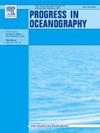用镭和氧同位素说明阿蒙森海波利尼亚附近冰川融水系统的变化
IF 3.8
3区 地球科学
Q1 OCEANOGRAPHY
引用次数: 0
摘要
由于富含铁的冰川融水(GMW)的输入,阿蒙森海冰川区(ASP)是南极洲周围生物产量最高的地区。然而,南极大陆冰川融水的来源和流向,以及自从南极大陆冰川融水的主要供应地多特森冰架(DIS)在2011年后开始进入冷却期后,冰川融水的来源和流向发生了怎样的变化,目前仍不清楚。本研究介绍了 2020 年夏季澳大利亚南部海域 GMW 的分布情况。利用从潜在温度、盐度和溶解氧中提取的复合示踪剂估算了地下全球小鲸比例,并利用 226Ra 和 228Ra 估算了地表全球小鲸比例。结果表明,大西洋海岸项目中的全球降水潜能源于迪斯尼湾和松岛湾。从 DIS 融化的基底空腔上涌的地表 GMW 在卡塔帕克风的作用下向西北输送,而地表下的 GMW 则在混合层下向西北输送,上部沿 27.40 至 27.45 公斤/立方米的等压线(σθ)上涌至大气层保护区中心的地表。这些等值线的深度变化与冬季海冰形成所释放的卤水存量密切相关,表明海冰的形成影响了海水的σθ结构,进而影响了地下 GMW 的传输路径。与 2011 年相比,2020 年 ASP 中的 GMW 含量减少了近一半,传输路径也发生了变化。这些变化与 2012 年后从地下综合信息系统中排放的 GMW 量大幅减少相吻合。我们的研究证实,在散热器冷却期开始后,青藏高原大气中的全球升温潜能值系统发生了重大变化。本文章由计算机程序翻译,如有差异,请以英文原文为准。
Changes in glacial meltwater system around Amundsen sea Polynya illustrated by radium and oxygen isotopes
The Amundsen Sea Polynya (ASP) is the most biologically productive area around Antarctica due to the input of iron-rich glacial meltwater (GMW). However, the source and path of GMW in the ASP, and how these have changed since the Dotson Ice Shelf (DIS), a primary GMW supplier, began experiencing a cooling period after 2011, remain unclear. This study presents the distribution of GMW in the ASP during the austral summer of 2020. Subsurface GMW proportions were estimated using a composite tracer derived from potential temperature, salinity, and dissolved oxygen, while surface GMW were using 226Ra and 228Ra. The results indicate that GMW in the ASP originates from DIS and Pine Island Bay. Surface GMW upwelled from the melting basal cavity of DIS is transported northwestward by katabatic winds, while subsurface GMW is transported northwestward beneath the mixed layer, with the upper portion upwelling to the surface in the ASP center along isopycnals (σθ) of 27.40 to 27.45 kg/m3. Depth variations of these isopycnals correlate well with brine inventories released by winter sea ice formation, suggesting that sea ice formation influences seawater σθ structures and consequently the transport path of subsurface GMW. Compared to 2011, the GMW content in the ASP in 2020 decreased by nearly half, and the transport routes have also changed. These changes align with the significantly reduced GMW discharge from the DIS after 2012. Our study confirms that the GMW system in the ASP has undergone significant changes following the onset of the cooling period experienced by the DIS.
求助全文
通过发布文献求助,成功后即可免费获取论文全文。
去求助
来源期刊

Progress in Oceanography
地学-海洋学
CiteScore
7.20
自引率
4.90%
发文量
138
审稿时长
3 months
期刊介绍:
Progress in Oceanography publishes the longer, more comprehensive papers that most oceanographers feel are necessary, on occasion, to do justice to their work. Contributions are generally either a review of an aspect of oceanography or a treatise on an expanding oceanographic subject. The articles cover the entire spectrum of disciplines within the science of oceanography. Occasionally volumes are devoted to collections of papers and conference proceedings of exceptional interest. Essential reading for all oceanographers.
 求助内容:
求助内容: 应助结果提醒方式:
应助结果提醒方式:


